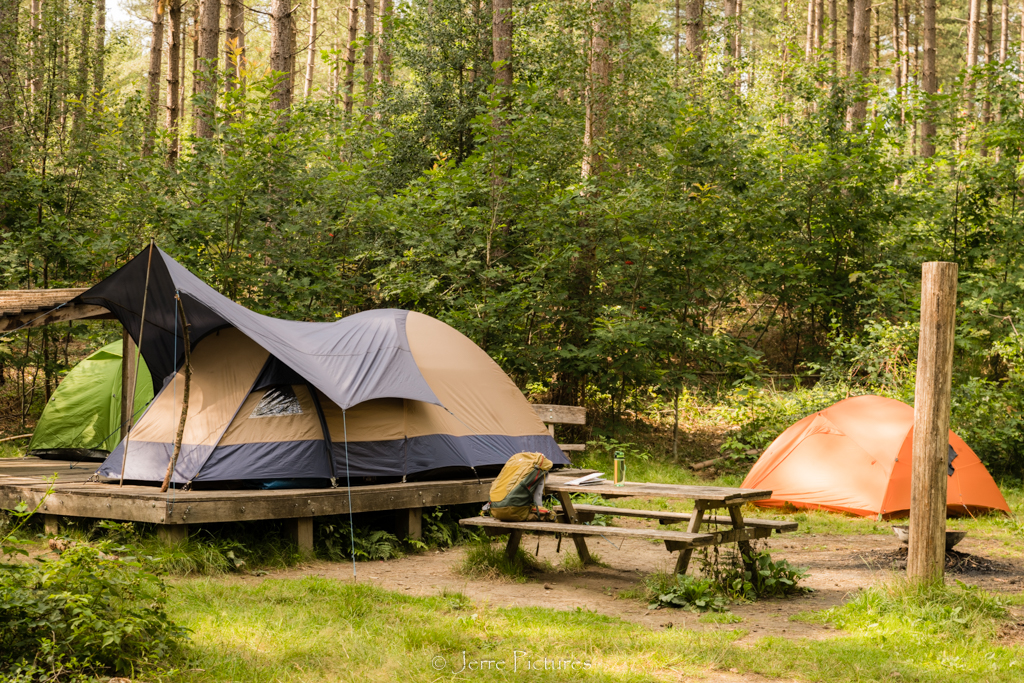Have you ever heard of pole camping?
It’s a special way of camping where you stay not on, but around a pole in nature. In the Netherlands, you can find about 50 pole camping sites scattered across the country. The beauty of it is that you can stay here for free, right in the middle of or on the edge of stunning natural areas. It’s actually the only legal form of ‘wild camping’ in the Netherlands & Belgium. But where do you find these pole camping sites, and what can you expect from a pole camping adventure?
What is pole camping exactly?
With pole camping, you get the opportunity to legally wild camp in the wilderness of the Netherlands & Belgium. At these designated camping spots, usually located in wooded areas, you’ll find a pole or a water pump with the characteristic sign ‘Pole Camping.’ Officially, you are allowed to camp within a radius of 10 meters from this pole, but often, you can use the whole area for your tent. However, please note that most pole camping sites were managed by Staatsbosbeheer (State Forest Service), but as of June 1st, 2020, these locations have been definitively closed. (dis means for most of the pole camping spots in the Netherlands are definitively closed)
The rules for pole camping:
Camp within 10 meters of the pole. You can stay for a maximum of 72 hours (some places only allow 24 hours, always check the local rules!). A maximum of 3 small tents is allowed per pole camping site. Leave no waste behind and bring your own garbage bag. Digging is usually not allowed. No open fires are allowed, but you can cook on a camping stove or primus. During extremely dry conditions, even that may be prohibited. Always check the rules on-site.
Facilities at the pole camping locations:
Prepare for a basic camping experience, as there are usually limited facilities available at the pole camping sites. Some places may still have a water pump for cooking and washing, but the water is not drinkable. Please be aware that since the summer of 2019, building a campfire is no longer permitted at any pole camping site.
In Belgium, pole camping is still allowed, but in some places, a reservation is required, even though it’s free. This is to prevent certain locations from becoming too crowded and causing damage to nature, or to avoid accidents, especially during the hunting season.
For those who prefer not to follow the rules, an important tip: visit only the places where you can abide by the regulations. All camping sites are generally not state-owned (except for Staatsbosbeheer), but are managed by private organizations or local farmers. On the attached map, you can find all the pole camping sites in Belgium and The Netherlands, where red dots indicate closures, yellow dots denote uncertainty, green dots are open, and gray dots require reservations (the link is mostly in the description of that point). Please note that I am not responsible for any possible inaccuracies on the map, but I strive to keep it as up-to-date as possible.
If you’re looking for an adventurous and legal way of wild camping in the Netherlands Or Belgium, definitely consider pole camping. Enjoy the 1000-star overnight stay in the beautiful nature, follow the rules, and leave the places clean so that others can also enjoy this unique experience. Have a great time pole camping!
Important note! Most pole camping sites are not accessible by car. Only on foot or by bike. There is even a high chance that you will have to walk or cycle for kilometers before reaching them.
Tip: For Belgian pole camping sites, you can find more information here:

